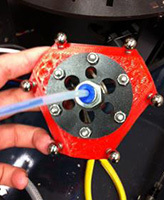
In a collaborative effort with Notre Dame’s College of Arts and Letters, College of Engineering Professor Paul McGinn led a team that recently adapted a 3-D printer for ceramics projects in the Department of Art, Art History, and Design.
Over the last year, McGinn, a professor in the Department of Chemical and Biomolecular Engineering, worked with Bill Kremer, a ceramics professor in the Department of Art, Art History, and Design; junior chemical engineering major Katie Hansen; and MFA graduate student Nathan Smith to retrofit a plastic-extruding 3-D printer to print in clay.
“It’s nice to have the teamwork of engineers and artists,” Smith says.
The hope, McGinn says, “is to expand 3-D printing technologies beyond industrial design and engineering—and explore novel uses of 3-D ceramic printing for artistic endeavors and creative expression.”
How It Works

To create a 3-D printed object, the designer must first use a computer aided design (CAD) program to make a blueprint that can be divided into digital cross-sections. Following that guide, the printer then deposits thin layers of material, re-assembling the slices into a three-dimensional object.
McGinn notes that in the burgeoning field of 3-D printing, many people are exploring the use of materials other than plastic—including clay, cement, and even chocolate. However, the existing technology for printing with clay was cost-prohibitive for most artists.
The Notre Dame team’s goal has been to develop a simple approach to ceramic printing that is affordable enough to be placed in art studios, he says. “While it will sacrifice some of the precision achieved with more complex printing systems, keeping it inexpensive can have a greater impact on the creative and artistic world.
“It is our hope that it will be extended to art programs at other universities, and even to high schools.”
That goal is already becoming a reality, thanks to the Research Experience for Teachers program at Notre Dame. This past summer, McGinn worked alongside local New Prairie High School math teacher Alexa Kutch and Culver Academy chemistry teacher Phil Cook to build another 3-D printer for high school use. Kutch is using the printer in her geometry class this fall.
McGinn says he will continue to work with New Prairie High School and also looks forward to partnering with other schools to bring 3-D printing into their technology and art programs.
Exploring Possibilities
While the team members are still working through some issues with the 3-D printer—including how to reduce the number of air bubbles in the clay and the amount of time it takes to print objects—they are already excited about the possibilities the project offers.
“I want to see more successful objects that are larger and more complex,” Hansen says. “I’m looking forward to getting as close to a perfect design as I can.”
Smith says that one of the advantages of the printer will be its ability to print small, fine details in ceramics and build into spaces that would be difficult to do by hand. He says the printer could also offer a new avenue for artists with physical limitations.
“Maybe they can’t physically work at the wheel or use their hands to create something, but with a design program they could make something and see their design come to life,” he says.
Research Associate Chad Hartwig, who received his MFA in ceramics from Notre Dame in 2011, began working on the project this fall and also sees great potential for the technology.
“I see a real integration into ceramics and sculpting using the printer,” he says. “I see it as another tool an artist has to interpret the world around us.”
Learn More >
- Department of Art, Art History, and Design
- Notre Dame College of Engineering
- Bill Kremer faculty page
- Paul McGinn faculty page
- 3-D printing of ceramics project blog
- Research Experience for Teachers at Notre Dame
Originally published by at al.nd.edu on November 06, 2013.